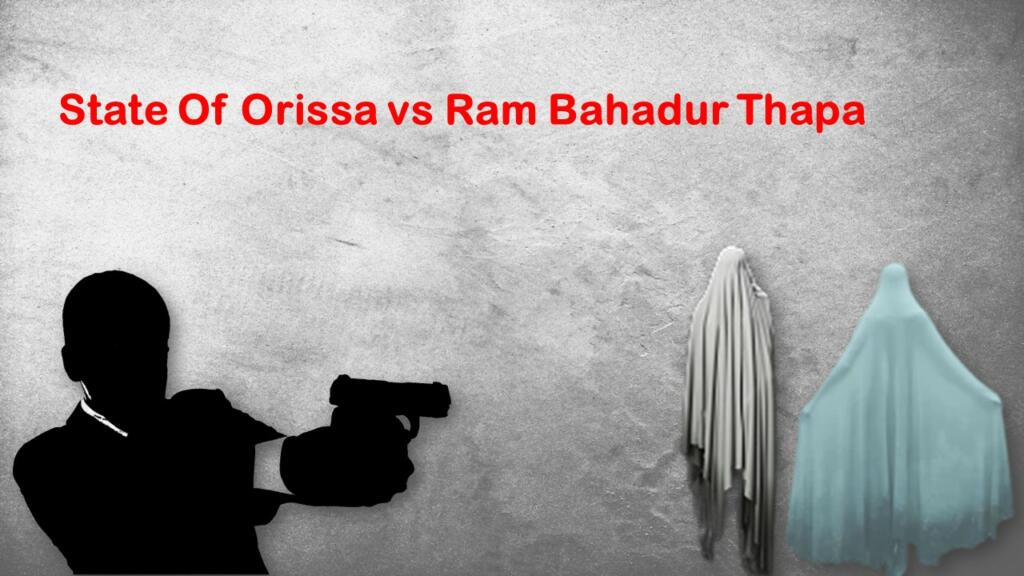Orissa Vs Ram Bahadur Thapa case: Ghosts are part of human society. Their concept has been there ever since the first conscious sapiens came into being. Consequently, they are part of the legal system as well. There have been cases where people have claimed innocence in the name of ghosts, and the court let them go.
Facts of the Orissa Vs Ram Bahadur Thapa case
An abandoned aerodrome existed in Rasgovindpur village of Balasore district. Local folklore was filled with ghost stories. Despite that, a gentleman named Jagat Bandhu Chatterjee wanted to buy aeroscrap. In April 1958, he came to Rasgovindpur for preliminary analysis. A Nepali servant named Ram Bahadur Thapa accompanied him. Both Chatterjee and Nepali also stumbled upon the ghost stories in the locality.
On May 20, 1958, a person named Chandra Majhi of Telkundi village stopped at the tea stall of Krishna Chandra Patro in Rasgovindpur. He feared ghosts and so did not find it apt to go to the village. However, Jagat Bandhu Chatterjee and his Nepalese servant Thapa had other ideas in mind. They persuaded the tea seller to accompany them in ferrying Chandra to Telkundi. The mission was successful, but not the return.
Also read: The Jan Vishwas (Amendment of Provisions) Bill, 2022: The bill which truly justifies its name
While returning, they saw some extravagant movement of human shades and lights. Thapa drew his Khurki and charged at them. Before he could gain control, a girl named Gelhi Majhiani was dead. Two other girls and Patro got injured. Nepali was charged with Sections 302 for murder, section 324 and 326 for voluntarily causing hurt. However, even after the charges were proven, the Sessions Court let Thapa go. The court relied on Section 79 of the IPC in this case.
Section 79 is used as a protective tool when a person has committed a crime, but in good faith. Another factor necessary to relieve the accused is that his/her state of mind genuinely failed to understand the real facts at hand. It shows that the person did not have any intention of committing a crime and did it in good faith.
Also read: Indian IT Act must be amended to curb the excess of big corporations
Broad understanding of Section 79
The matter ultimately reached the Orissa High Court. The High Court took its time getting to the depth of the case. It only considered Chatterjee’s statements as reliable, as other witnesses had lost trust due to constant changes in their statements. Even the angle of Chatterjee’s sympathy towards his own servant was not considered since Chatterjee’s statement remained constant throughout the hearings.
The main question before the court was whether Nepali acted in good faith. The High Court acknowledged that good faith requires due care and attention. However, there is no universal prerequisite for these criteria. The court relied on the interpretation laid out in the Emperor v. Abdeol Wadood Ahmed case.
In that case, the Bombay High Court had held that the honest conclusion of a calm and philosophical mind varies from a person excited by sectarian zeal and untrained to reason. Another case named Bhawoo Jivaji vs. Mulji Dayal was also cited. In this case, the Bombay High Court had opined that the question of good faith depends on the facts and circumstances of each case. The Orissa High Court also looked into similar observations in the Po Mye v. The King case.
Thapa fulfilled every criteria
It was then a question of whether Thapa satisfied the criteria laid down in these interpretations. After closely studying the facts, the High Court observed that Thapa was Nepali, and that is why the only reliable reference for him were the people around him. In this case, his master Chatterjee and friend Patro were his guiding forces. Additionally, he was a firm believer in ghosts. Chatterjee and Patro should have worked towards educating him out of this belief. Instead, they were both adding rationality to his irrational beliefs.
Also read: Money Bill: All the times, Aadhaar was discussed in Supreme Court
The court took these facts into consideration and held that any person of Thapa’s mindset would react similarly. To substantiate its argument, the High Court said that Chatterjee and Patro, who are of superior intellect, also inferred from the lights and movements that they were ghosts.
Ultimately, there was no reason for the Nepalis to believe that no ghost was there. Petitioners then urged that Thapa could have flashed the torch, which makes it a clear case of acting without due care and attention. The court did not agree with it and held that he had zero doubt in his mind and that, therefore, his impulses did not allow him to flash the torch.
Two other similar cases, namely the Waryam Singh Case and the Bouda Koi Case, were also looked at for reference. Thapa was held to be eligible for relief under Section 79 of the IPC and was released.
The Orissa Vs Ram Bahadur Thapa case is cited as one of the few and far between instances in which the “innocent until proven guilty” principle was upheld until the final words of judgement. The only fear is that nefarious elements may use it for their own gains. But, then again, that is true for most observations in criminal law.
Support TFI:
Support us to strengthen the ‘Right’ ideology of cultural nationalism by purchasing the best quality garments from TFI-STORE.COM
Also Watch:
https://www.youtube.com/watch?v=sRz3tIP58pQ
